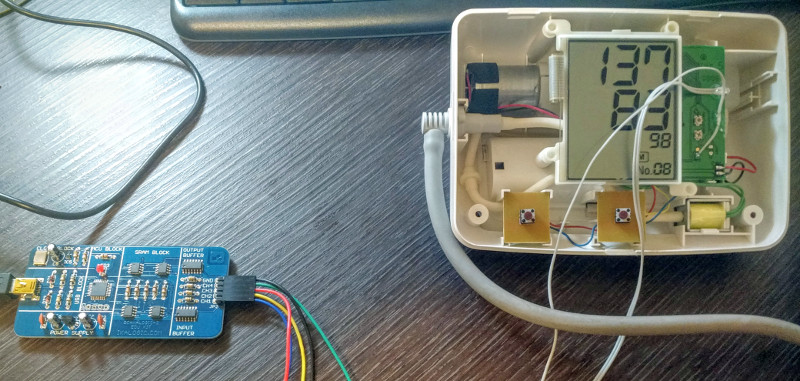[Eduardo] contacted us about his success at connecting a blood pressure monitor to the web. He pulled this off by locating the chip responsible for storing the blood pressure data after being measured. It was a simple I2C EEPROM from which he dumped the data a sniffed communications with a 4 bit logic analyzer. [Eduardo] published all of his findings on that communication scheme so check out his post for more on that. The gist of it is that he implemented his reverse engineered protocol using an ESP8266, the ubiquitous cheap WiFi board that has become a go-to for web-connected anything like power monitors and underpowered but awesome server farms. Check out the Hackaday Dictionary entry for more on this board.
[Eduardo] is not the first on the scene with such a device, you can see a Withings device and a blipcare device available on Amazon. What this hack from [Eduardo] does provide is evidence of a much cheaper route for connecting vital medical data from a geographically distant, and perhaps technophobic family member. Lets take a walk down hypothetical lane, shall we? Uncle Bob in Albuquerque who doesn’t have any local family might be a good candidate for such a hacked device, everyone knows it’s like pulling teeth to get elderly family members to report some health information to loved ones… but with [Eduardo’s] hack it’s simple. Embed the hardware (assuming you know the login creds ahead of time) into a new BPM, send it to him as a gift, and Bob’s your uncle.
We haven’t seen too many blood pressure monitor hacks, but one entry from the Hackaday Prize dubbed “the pain machine” included monitoring the user’s blood pressure. We also covered an interesting hack on monitoring your heart rate with a piezo element.
A quick demo of [Edward’s] cuff is found below.
















ok, i have a question unrelated to this post but i hope it generates a response. I would like to add closed captions to my videos, and after googling equipment i know i can’t but the stuff…AND don’t need it!! so, is there a way to use a beagle, a mic and a open source “conttana-type” speech processor to build a CC device?
It’s extremely poor etiquette. Post something on stackexchange.
thx…will do…AND i don’t do this kinda post often
Once is TOO many.
no offense meant
The point was made without your comment that didn’t bring anything positive.
If you want is a subtitle to your video,
then you most probably want a .srt file to be produced (a simple text file).
Or if you post to youtube, there is also a subtitle option.
So there is no need to physically burn the subtitle into the picture.
For subtitle creation, you can use google now/voice service for audio recognition. It would be a nice hack in itself.
thx…i’m not on mobile so don’t know how to use google now…but, yeah, that would be cool
I found this very interesting. Earlier this year I spent a weekend in hospital being monitored after a “extreme blood pressure event” – Kingston Hospital in SW London, UK. The cardiac ward had monitors on all beds which were networked, so that not only could the nurses station see them, but the consultants could see them from their offices both in the hospital and at whichever other London hospital they worked at. This sort of device would be a great add on to that. I have twice had to wear a 24 hour monitor. The first time some years ago it used a micro cassette tape. This year it used a CF card. Next time a 4G connection?
There is now a lot of data on the use of tele-medicine for older people, and in all cases it seems to not only be more cost effective, but it addresses problems outlined in the post of getting to patients who are hard to reach for geographic and other reasons.
I’m going to have a look at doing this for my own portable monitor. well done Eduardo.
Had a look at the Withings & iHealth devices. Both are Bluetooth and work with a smart phone. also starting prices are around $100. The Blipcare is WiFi and connects to your home network and can be monitored on a smartphone, but I can’t tell from the website if you can access the data outside the home. There is also an Omron device which connects by USB and the data can by accessed via the BiLink health data service. Again the info available is not much at a quick glance.
So from my quick and dirty survey it looks like Eduardo’s has some unique features and is really cheap. However you do this you need the monitor anyway, so getting the data accessible in a cost effective way is the trick.
Again, nice hack Eduardo.
Thanks Sadiq, I’m glad you liked it! The ESP8266 is so cheap that it makes this project really cost effective, if you don’t mind doing the work. You could even go further with the hack and turn it into an ABPM machine without too much trouble. That would allow you to monitor the pressure during 24 hours, giving you a better sample of your BP. The device could store all the measurements in the EEPROM and push it to the cloud once in reach of your home’s WiFi network, for example. Just be mindful you’re modifying a medical device, and as such it does not replace a proper diagnostic from a physician. Thanks again!
My elliptical exercise machine has an electronic display, but no download/offload capability, maybe this is the route to consider. My digital BP meter doesn’t connect to anything either…. hmmmm.
This idea of sniffing data between the MCU and other components, be it an EEPROM, a display or some other sort of storage can be applied to any kind device, really.
Why not, right? :)
How to connect NODEMCU or Arduino uno with digital Blood pressure meter